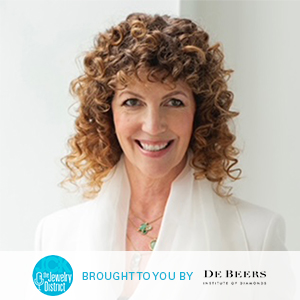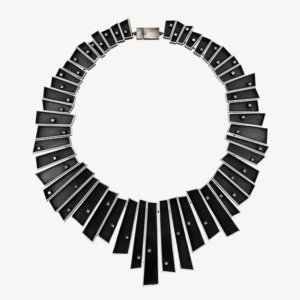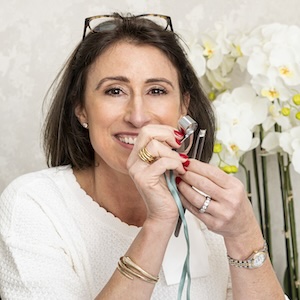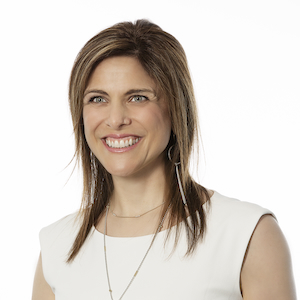
JCK editor-in-chief Victoria Gomelsky and news director Rob Bates welcome Monica Stephenson, founder of Anza Gems and immediate past president of the nonprofit Ethical Metalsmiths. A well-known name in responsible jewelry sourcing, Monica recently returned from her 17th trip to East Africa. She shares the path that led from an early love of all things shiny to working at a Seattle startup named Amazon and eventually to a life-changing first visit to Kenya and Tanzania. Monica also offers simple, actionable advice for others looking to operate more responsibly.
Listen Now
Sponsored by De Beers: institute.debeers.com
Show Notes
05:53 From magpie to entrepreneur
08:23 Tech whispering to the jewelry team
12:21 A life-altering journey to Africa
16:02 The hands-on approach
17:46 Putting ladies first
22:12 Bridging the gap
25:25 Small steps, big impact
Episode Credits
Hosts: Rob Bates and Victoria Gomelsky
Producer and engineer: Natalie Chomet
Plugs: @jckmagazine; institute.debeers.com
Show Recap
From magpie to entrepreneur
Victoria introduces this week’s guest, Anza Gems founder Monica Stephenson, and asks what led her into the jewelry business. Even as a child, Monica had “magpie tendencies” and was drawn to sparkly things. Her father started working in jewelry sales during her teen years, which introduced her to the industry and led her to take a part-time job at an independent jewelry store while attending the University of Iowa in the 1990s. “I ended up completely hooked,” she recalls. As an art history and fine arts major, “I instantly recognized that jewelry is an art form.”
After graduating and getting married, Monica headed west when her husband “decided he was going to submit his résumé to this little Seattle-based online bookseller in 1999 called Amazon.com.” Within a few years, Amazon tapped Monica, too, to join its growing ranks—as part of a small team launching the site’s new jewelry store, which debuted in 2004.
Tech whispering to the jewelry team
Rob wants to know what it was like to work on jewelry for Amazon. “Jewelry is so high-touch and emotional. The business is about relationships,” Monica observes. “Working for a tech company is the exact opposite. Amazon is all about being data-driven.” Because she “spoke” both jewelry and tech, Monica served as a “tech translator to the jewelry team,” she says. Her ability to bridge those two worlds, blending analytics and data with gut instinct about what consumers want, has served her well over the years.
After the intensity of launching Amazon’s jewelry line, Monica took time off to stay home with her two young daughters but remained connected to the jewelry world by starting the blog iDazzle.com in 2008, interviewing independent designers and attending trade shows. “I found myself really attracted to stories about people who were making responsible, ethical decisions in their business, and I ended up following that thread,” she says.
A life-altering journey to Africa
Monica’s unlikely move from blogger to gem dealer sprang from a combination of serendipity and curiosity.
During her blogging years, Monica caught sight of a tweet about documentarians planning a trip to Kenya and Tanzania to explore gem mining for what would become the award-winning film Sharing The Rough. “For some reason, I just had to go,” she says. Though she knew no one associated with project, she flew 9,000 miles and “ended up next to a tsavorite mine in Kenya,” she says. “What I found on that trip was really eye-opening and life-changing. Afterwards I just couldn’t stop thinking about it, writing about it.” The land was beautiful. The artisanal miners were hardworking and skilled. But the poverty was overwhelming. The need for infrastructure, funding, and education was dire.
Monica’s trip prompted her to develop what she calls a circular business plan: She could travel to East Africa, buy rough gems, have them cut in the U.S., then sell them and reinvest 10 percent of sales into education and community development initiatives to empower the artisanal gemstone trade in Africa. Anza Gems is “a for-profit business, but it definitely has that idea of reinvesting back into those mining communities to see if we can make an impact,” she explains.
The hands-on approach
Rob points out that mining areas have an existing ecosystem that, even with the best intentions, can be hard to navigate as an outsider. For Monica, the key is pinpointing where you can make the biggest impact to truly benefit the communities and then “really being on the ground, being involved, having direct interaction and oversight,” she says.
“You have to know your local partners,” she continues. “And then you have to be in constant conversation and iteration to move these conversations forward.” For example, if you raise money for solar panels, you need to make sure the solar panels actually get installed and function correctly. “Accountability is really important.”
Putting ladies first
Monica recently honed her mission to focus on empowering women in the supply chain. She credits GIA with sparking the idea through its artisanal mining education project, piloted in Tanzania shortly before the pandemic. “They were specifically targeting women miners, who are extraordinarily marginalized,” she says. “I was instantly intrigued. I could see the kind of impact that could be made in the region and particularly with women miners. When you invest in women, it tends to be really good for the community. It ripples outwards.”
Giving women the knowledge to evaluate the quality of the rough stones they mine was a brilliant first step. Monica decided to tackle the next logical step: getting the women’s gems to market. “We had this amazing dialogue with 50 or 60 women that became the core of Moyo Gems,” a responsible miner-to-market collaboration designed to empower and protect women miners. The group organized several “incredibly successful” market days in 2019 that allowed miners to earn 3 to 10 times more than they would have through other routes, Monica says.
But just as momentum was building, business came to screeching halt as COVID struck. Knowing the miners would soon face food insecurity without international buyers for their product, Moyo swung into action. “Within a number of months, we coordinated aid through [the nonprofit] Gem Legacy,” she says. “We also figured out a way to do remote markets, where my export broker was able to meet with the miners on my and the other traders’ behalf, buy their gems, and put some much-needed income back into this region. We had six or eight market days while everything was shut down for COVID.”
When Monica returned to the mining region in May 2022, she was overwhelmed to find herself “wrapped in this amazing embrace by these mining communities who didn’t have a lot of other options during that time.” Far from seeing herself as a savior, Monica considers herself privileged to have an opportunity to interact with African miners and to see the work they do up close.
Bridging the gap
Monica acknowledges the logistical challenges of traveling to remote mining communities, but says the payoff is seeing the incredible beauty of East Africa. The hardest part is not driving on unpaved roads, she says—it’s seeing the realities of the miners’ working life. Miners do “really difficult work under pretty challenging conditions,” Monica says. “How do we make that better collectively? How do we bridge the gap between [that and] the glitz and glamour you associate with jewelry in Vegas, for instance?”
Small steps, big impact
Ethical business practices can start closer to home, Monica says. Know your own values and find suppliers who share them, she urges. Improvement “doesn’t have to be sourcing. It can be how you run your studio. It can be reducing emissions. It can be using local labor,” she says. “Let’s focus on what’s important to us, what we can control…and engage on it.”
Any views expressed on this podcast do not reflect the opinion of JCK, its management, or its advertisers.
Follow JCK on Instagram: @jckmagazineFollow JCK on Twitter: @jckmagazine
Follow JCK on Facebook: @jckmagazine





